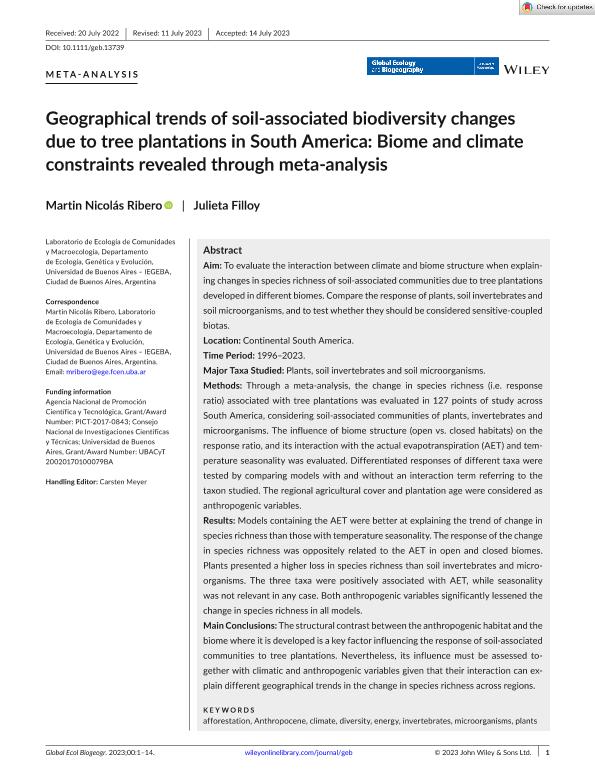Artículo
Geographical trends of soil‐associated biodiversity changes due to tree plantations in South America: Biome and climate constraints revealed through meta‐analysis
Fecha de publicación:
07/2023
Editorial:
Wiley Blackwell Publishing, Inc
Revista:
Global Ecology and Biogeography
ISSN:
1466-822X
Idioma:
Inglés
Tipo de recurso:
Artículo publicado
Clasificación temática:
Resumen
AimTo evaluate the interaction between climate and biome structure when explaining changes in species richness of soil-associated communities due to tree plantations developed in different biomes. Compare the response of plants, soil invertebrates and soil microorganisms, and to test whether they should be considered sensitive-coupled biotas.LocationContinental South America.Time Period1996–2023.Major Taxa StudiedPlants, soil invertebrates and soil microorganisms.MethodsThrough a meta-analysis, the change in species richness (i.e. response ratio) associated with tree plantations was evaluated in 127 points of study across South America, considering soil-associated communities of plants, invertebrates and microorganisms. The influence of biome structure (open vs. closed habitats) on the response ratio, and its interaction with the actual evapotranspiration (AET) and temperature seasonality was evaluated. Differentiated responses of different taxa were tested by comparing models with and without an interaction term referring to the taxon studied. The regional agricultural cover and plantation age were considered as anthropogenic variables.ResultsModels containing the AET were better at explaining the trend of change in species richness than those with temperature seasonality. The response of the change in species richness was oppositely related to the AET in open and closed biomes. Plants presented a higher loss in species richness than soil invertebrates and microorganisms. The three taxa were positively associated with AET, while seasonality was not relevant in any case. Both anthropogenic variables significantly lessened the change in species richness in all models.Main ConclusionsThe structural contrast between the anthropogenic habitat and the biome where it is developed is a key factor influencing the response of soil-associated communities to tree plantations. Nevertheless, its influence must be assessed together with climatic and anthropogenic variables given that their interaction can explain different geographical trends in the change in species richness across regions.
Archivos asociados
Licencia
Identificadores
Colecciones
Articulos(IEGEBA)
Articulos de INSTITUTO DE ECOLOGIA, GENETICA Y EVOLUCION DE BS. AS
Articulos de INSTITUTO DE ECOLOGIA, GENETICA Y EVOLUCION DE BS. AS
Citación
Ribero, Martin Nicolas; Filloy, Julieta; Geographical trends of soil‐associated biodiversity changes due to tree plantations in South America: Biome and climate constraints revealed through meta‐analysis; Wiley Blackwell Publishing, Inc; Global Ecology and Biogeography; 7-2023; 1-14
Compartir
Altmétricas




